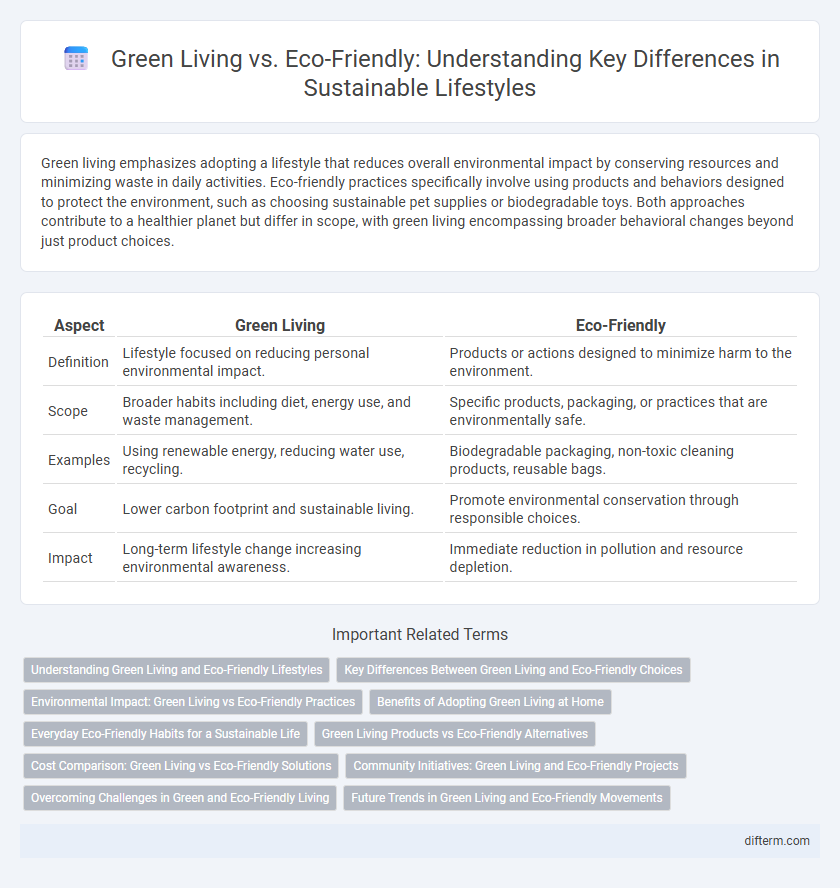Green living emphasizes adopting a lifestyle that reduces overall environmental impact by conserving resources and minimizing waste in daily activities. Eco-friendly practices specifically involve using products and behaviors designed to protect the environment, such as choosing sustainable pet supplies or biodegradable toys. Both approaches contribute to a healthier planet but differ in scope, with green living encompassing broader behavioral changes beyond just product choices.
Table of Comparison
| Aspect | Green Living | Eco-Friendly |
|---|---|---|
| Definition | Lifestyle focused on reducing personal environmental impact. | Products or actions designed to minimize harm to the environment. |
| Scope | Broader habits including diet, energy use, and waste management. | Specific products, packaging, or practices that are environmentally safe. |
| Examples | Using renewable energy, reducing water use, recycling. | Biodegradable packaging, non-toxic cleaning products, reusable bags. |
| Goal | Lower carbon footprint and sustainable living. | Promote environmental conservation through responsible choices. |
| Impact | Long-term lifestyle change increasing environmental awareness. | Immediate reduction in pollution and resource depletion. |
Understanding Green Living and Eco-Friendly Lifestyles
Green living emphasizes reducing environmental impact through sustainable practices like conserving energy, minimizing waste, and choosing renewable resources, while eco-friendly lifestyles prioritize using products and habits that cause minimal harm to ecosystems. Both approaches encourage conscious consumerism and sustainable habits but green living is broader, encompassing overall environmental responsibility and long-term sustainability. Understanding these distinctions aids in making informed lifestyle choices that promote environmental health and resource conservation.
Key Differences Between Green Living and Eco-Friendly Choices
Green living emphasizes a holistic lifestyle shift that incorporates sustainable habits across daily routines, including energy conservation, waste reduction, and mindful consumption. Eco-friendly choices specifically target products or actions that minimize environmental impact, such as using biodegradable materials or renewable energy sources. The key difference lies in green living as a comprehensive philosophy, while eco-friendly choices represent individual steps within that broader framework.
Environmental Impact: Green Living vs Eco-Friendly Practices
Green living emphasizes daily lifestyle choices that reduce carbon footprints, such as using renewable energy, minimizing waste, and adopting sustainable transportation. Eco-friendly practices focus on products and behaviors designed to lessen harm to ecosystems by promoting biodegradable materials, conserving water, and reducing pollution. Both approaches contribute significantly to environmental impact reduction, with green living encompassing broader habits and eco-friendly practices targeting specific sustainability actions.
Benefits of Adopting Green Living at Home
Adopting green living at home reduces energy consumption by utilizing renewable resources and improving insulation, which lowers utility bills and minimizes environmental impact. Incorporating eco-friendly products and sustainable practices enhances indoor air quality and promotes healthier living conditions for family members. These lifestyle changes contribute to long-term savings and support global efforts to combat climate change through decreased carbon footprints.
Everyday Eco-Friendly Habits for a Sustainable Life
Adopting everyday eco-friendly habits like reducing plastic use, conserving water, and choosing energy-efficient appliances significantly contributes to green living. Incorporating sustainable practices such as composting organic waste and opting for reusable products minimizes environmental impact and supports resource conservation. These small, consistent actions collectively foster a lifestyle that prioritizes ecological balance and long-term planetary health.
Green Living Products vs Eco-Friendly Alternatives
Green Living products often emphasize sustainability through natural materials and energy efficiency, prioritizing reduced environmental impact in everyday use. Eco-Friendly alternatives focus on minimizing harm by using recyclable or biodegradable materials and lowering carbon footprints during production and disposal. Choosing between the two depends on specific lifestyle goals, such as reducing waste or conserving resources, both contributing significantly to sustainable living.
Cost Comparison: Green Living vs Eco-Friendly Solutions
Green living often involves initial investments like energy-efficient appliances and home insulation that provide long-term savings through reduced utility bills. Eco-friendly solutions tend to focus on specific products or habits, such as reusable bags and biodegradable cleaners, which typically require lower upfront costs but may not yield substantial financial returns. Comparing both approaches highlights that green living may demand higher initial expenses with greater overall economic benefits, while eco-friendly solutions offer accessible, incremental savings suited for budget-conscious individuals.
Community Initiatives: Green Living and Eco-Friendly Projects
Community initiatives in green living promote sustainable habits through urban gardening, zero-waste programs, and renewable energy cooperatives that actively reduce carbon footprints. Eco-friendly projects often involve collaborative efforts such as plastic reduction campaigns, local recycling drives, and educational workshops aimed at increasing environmental awareness. These initiatives collectively foster resilient neighborhoods by encouraging resource sharing, conservation practices, and improving overall environmental health.
Overcoming Challenges in Green and Eco-Friendly Living
Overcoming challenges in green and eco-friendly living involves adopting sustainable habits despite limited access to resources or higher initial costs. Embracing renewable energy, reducing waste through recycling and composting, and choosing eco-friendly products facilitate long-term environmental benefits. Community support and education play crucial roles in making green living accessible and practical for diverse lifestyles.
Future Trends in Green Living and Eco-Friendly Movements
Future trends in green living emphasize the integration of smart home technologies and renewable energy sources to reduce carbon footprints and enhance sustainability. Eco-friendly movements are increasingly driven by circular economy principles, promoting waste reduction through recycling, upcycling, and sustainable product design. Growing consumer demand for biodegradable materials and zero-waste lifestyles is shaping market innovations and global environmental policies.
Green Living vs Eco-Friendly Infographic

 difterm.com
difterm.com